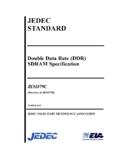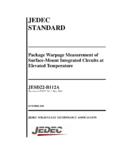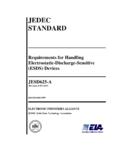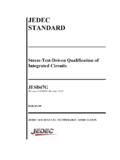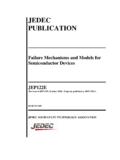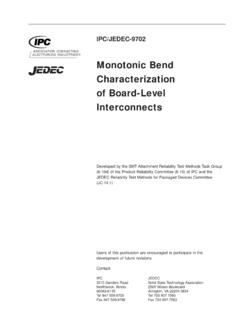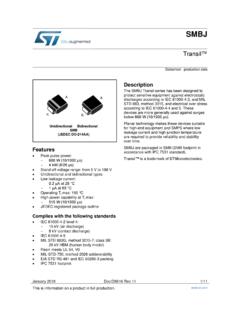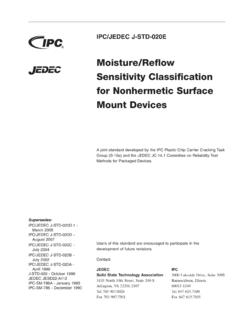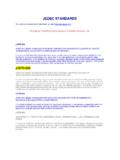Transcription of 'Thermal Characteristics of Linear and Logic Packages ...
1 thermal Characteristics of Linear and Logic Packages Using jedec PCB Designs SZZA017A. September 1999. 1. IMPORTANT NOTICE. Texas Instruments and its subsidiaries (TI) reserve the right to make changes to their products or to discontinue any product or service without notice, and advise customers to obtain the latest version of relevant information to verify, before placing orders, that information being relied on is current and complete. All products are sold subject to the terms and conditions of sale supplied at the time of order acknowledgement, including those pertaining to warranty, patent infringement, and limitation of liability. TI warrants performance of its semiconductor products to the specifications applicable at the time of sale in accordance with TI's standard warranty. Testing and other quality control techniques are utilized to the extent TI deems necessary to support this warranty.
2 Specific testing of all parameters of each device is not necessarily performed, except those mandated by government requirements. CERTAIN APPLICATIONS USING SEMICONDUCTOR PRODUCTS MAY INVOLVE. POTENTIAL RISKS OF DEATH, PERSONAL INJURY, OR SEVERE PROPERTY OR. ENVIRONMENTAL DAMAGE ( CRITICAL APPLICATIONS ). TI SEMICONDUCTOR. PRODUCTS ARE NOT DESIGNED, AUTHORIZED, OR WARRANTED TO BE SUITABLE FOR. USE IN LIFE-SUPPORT DEVICES OR SYSTEMS OR OTHER CRITICAL APPLICATIONS. INCLUSION OF TI PRODUCTS IN SUCH APPLICATIONS IS UNDERSTOOD TO BE FULLY. AT THE CUSTOMER'S RISK. In order to minimize risks associated with the customer's applications, adequate design and operating safeguards must be provided by the customer to minimize inherent or procedural hazards. TI assumes no liability for applications assistance or customer product design. TI does not warrant or represent that any license, either express or implied, is granted under any patent right, copyright, mask work right, or other intellectual property right of TI covering or relating to any combination, machine, or process in which such semiconductor products or services might be or are used.
3 TI's publication of information regarding any third party's products or services does not constitute TI's approval, warranty or endorsement thereof. Copyright 1999, Texas Instruments Incorporated 2. Contents Title Page Abstract .. 1. Introduction .. 1. Background .. 1. Correlation Study .. 4. Derating Curves .. 5. Conclusion .. 6. Acknowledgment .. 6. References .. 6. List of Illustrations Figure Title Page 1 IC Package thermal Metrics .. 1. 2 JC Laboratory Measurement Method .. 2. 3 One-Quarter Package Model of 20-Pin SOIC Package .. 3. 4 Cross Section of 20-Pin SOIC Package on 2s2p PCB .. 4. 5 Derating Curves for 16-Pin DW SOIC Package .. 5. List of Tables Table Title Page 1 Critical PCB Design Factors for jedec 1s and 2s2p Test Boards .. 3. 2 Correlation Study Results Using jedec High-K PCB Design .. 4. iii iv Abstract In an effort to standardize integrated-circuit (IC) package thermal -measurement methods, jedec has released standards for test- board designs.
4 Typical thermal metrics reported are package thermal resistance from junction to ambient ( JA), and package thermal resistance from junction-to-case ( JC). Recent data generated by Texas Instruments (TI ) Linear and Logic package designers includes JA and JC measured, or modeled, on both a jedec low- thermal -conductivity (low K) PCB. design and a jedec high- thermal -conductivity (high K) PCB design. A study showed good correlation between modeled results and data taken in a laboratory. A web page provides the new thermal data for TI Packages . An additional feature of this web page allows the user to plot derating curves for each package, using the thermal data provided. Introduction Users of ICs need to know the thermal -dissipation performance of the plastic Packages used to encapsulate the ICs. Package thermal -resistance data allows the user to compare performance of different IC suppliers, as well as determine the limits of a package in a specific end-use environment.
5 thermal metrics, such as JA and JC, are used to compare thermal performance of plastic IC Packages . The thermal conductivity of all materials of the IC package and the test- board influence the thermal -resistance values reported by semiconductor manufacturers. Recent advancements in reporting of thermal data include standardized test- board designs. Prior to development of these standard test- board designs, IC manufacturers used their own PCB designs to generate thermal data; therefore, comparison of package thermal data between suppliers was not meaningful. Background thermal resistance is the resistance of the package to heat dissipation and is inversely related to the thermal conductivity of the package. The source of heat in a plastic IC package is the chip. All electrical circuits dissipate some power in the form of heat. This heat is conducted through the package into the ambient environment, and, in the process, the temperature of the die (TJ) rises above ambient.
6 The thermal conductivity of the silicon chip, die-attach epoxy, copper leadframe, and mold compound all affect the rate at which the heat is dissipated. The geometry of the package and of the printed circuit board (PCB) greatly influence how quickly the heat is transferred to the PCB and away from the chip. The most commonly used thermal metrics for IC Packages are thermal impedance measured, or modeled, from the chip junction to the ambient air surrounding the package ( JA) and thermal impedance measured, or modeled, from the chip junction to the case ( JC). Figure 1 is a thermal representation of a typical IC plastic package, with the silicon chip and the thermal metrics identified. TA. TJ JA TC. JC. Figure 1. IC Package thermal Metrics TI is a trademark of Texas Instruments Incorporated. 1. Mathematically, JA is defined as: q JA + (T * T ) P.
7 J A (1). Where: TJ = junction temperature of the chip TA = ambient temperature P = power to the chip JA is measured using the following steps:1. 1. IC package containing a test chip is mounted on a test board . 2. Temperature-sensing component of the test chip is calibrated. 3. Package/test- board system is placed in a still-air environment. 4. Known power is dissipated in the test chip. 5. After steady state is reached, the junction temperature is measured. 6. The difference in measured ambient temperature compared to the measured junction temperature is calculated and is divided by the dissipated power. Mathematically, JC is defined as: q JC + (T * T ) P. J C (2). Where: TJ = junction temperature of the chip TC = package case temperature P = power to the chip Measurement of JC is formalized in industry standards. Summarized, the procedure is: 1.
8 IC package containing a test chip is mounted on a test board . 2. The package, in a dead bug configuration, is pressure fitted to a copper cold plate (a copper block with circulating constant-temperature fluid). 3. Silicone thermal grease provides thermal coupling between the cold plate and the package. 4. Power is applied to the device. 5. Junction temperature of the test chip is measured. 6. Temperature of the package surface in contact with the cold plate is measured by a thermocouple pressed against this surface. 7. JC is calculated by dividing the measured temperature difference by the dissipated power. Figure 2 is a schematic representation of the laboratory method used to measure JC. Test PCB. thermal Grease Coolant In Cold Plate Coolant Out Thermocouple Figure 2. JC Laboratory Measurement Method 2. JA values are the most subject to interpretation.
9 Factors that can greatly influence the measurement and calculation of JA are: Whether or not the device is mounted to a PCB. PCB trace size, composition, thickness, geometry Orientation of the device (horizontal or vertical). Volume of the ambient air surrounding the device under test, and airflow Whether or not other surfaces are in close proximity to the device being tested To eliminate the test- board design as a variable in data reported by IC manufacturers, thermal test- board design standards have been developed and ,3 In August 1996, the Electronics Industries Association (EIA) released Low Effective thermal Conductivity Test board for Leaded Surface Mount Packages , EIA/JESD 51 3. In February 1999, the EIA released Test board With Two Internal Solid Copper Planes for Leaded Surface Mount Packages , EIA/JESD 51 7. These standards describe guidelines with parameters for thermal -test- board design for low effective thermal conductivity (one signal layer in the trace fanout area) and for PCB designs with high effective thermal conductivity (one power and one ground plane).
10 The specified parameters include the area of the test board , the amount of copper traces on the test board , and the resulting trace fanout area, each important to the heat-sinking Characteristics of the PCB. Prior to release of these standards, thermal -impedance data for similar Packages varied widely within the industry due to the use of different test- board designs. As the industry adopts this standard design methodology, thermal -impedance variations from test- board design should be minimized. The critical factors of these test- board designs are shown in Table 1. Table 1. Critical PCB Design Factors for jedec 1s and 2s2p Test Boards jedec LOW-K 1s jedec HIGH-K 2s2p TEST board DESIGN. (inch) (inch). Trace thickness Trace length PCB thickness PCB width 4 4. PCB length Power/ground-plane thickness No internal copper planes (2 planes). Figure 3 is an orthogonal view of a one-quarter package model for the 20-pin small-outline integrated-circuit (SOIC) package.










